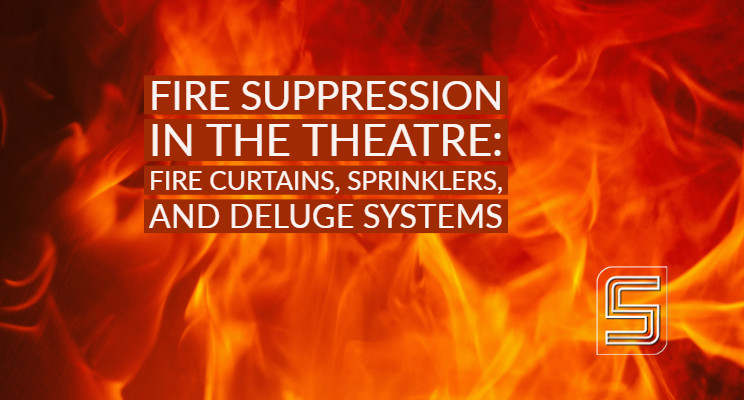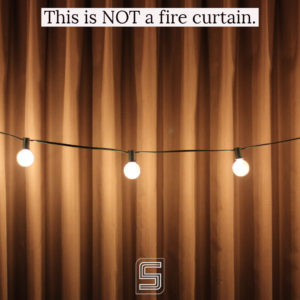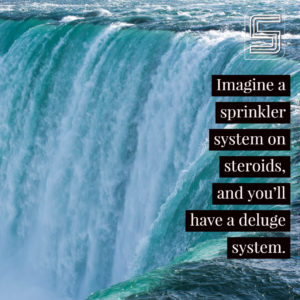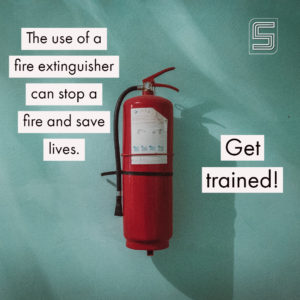

THE FIRE CURTAIN

Assuming the fire starts on stage, the fire curtain serves to separate the audience from the fire. Early fire curtains were often made with asbestos fibers to slow flame spread. A metal channel, known as a smoke pocket, keeps the curtain held tightly to the proscenium. Fire curtain rigging is designed with a trip wire type system. They can be manually triggered, or will ultimately be triggered when thermal links in the rigging melt as the heat levels rise. For the fire curtain to work, it needs to get to the floor—which is why stage designs that break the proscenium and block the path of the fire curtain should be avoided.
Fire curtains lose their effectiveness if they are not properly maintained. They should be tested regularly, including functions like the trip mechanism and the dashpots (which slow the curtain in its last few feet of descent).
With new construction, the standard says a fire curtain is required if the fly loft is over 50-feet in height.
THE SMOKE VENT
The smoke vent, at the top of the fly loft, is part of the fire curtain system. The smoke vent is designed to open as the fire curtain is dropped, giving the fire a path away from the audience with the intention of eliminating backdraft effects. Stagehands don’t like smoke vents because they leak when it rains, make noise when the wind blows, and require extra effort to reset once tripped. Smoke vents should be checked for function, as well as weatherproofing, when they’re inspected.
SPRINKLERS
Many theatres have conventional sprinklers, integrated with fire alarms, which alert the fire department when triggered. Clearly, sprinklers must not be painted, and care must be taken to keep them unobstructed. They should be tested annually by a professional to make sure they’re in good working order.
It’s important to note that atmospheric effects like fog or smoke can trigger sprinkler systems. Know what triggers your system. Also, know a legal and effective procedure to disable it. In many cases this requires a designated fire watch on premises during the show. Contact your local fire marshal for best practices in your region.
DELUGE SYSTEMS

While highly effective in fighting fires, they can cause massive amounts of damage to the stage space when triggered. They must be inspected on a regular basis, by a professional who knows how to avoid triggering the system. Accidentally triggering the system will destroy scenery, stage flooring, and anything in the orchestra pit—including pit lift machinery. Speak with your local fire marshal and your fire suppression vendor before any testing.
FIRE EXTINGUISHERS

YOUR FRIEND, THE FIRE MARSHAL
Sometimes, there is an adversarial relationship between the local fire marshal and theatre professionals. Don’t let that happen. Make your fire marshal your friend, because you’re both on the same side.
The theatre can be a dangerous place. Our goal as theatre professionals is to make it as safe as possible for our colleagues and our audience. To do that, we need to understand the fire prevention tools that are part of the theatre space. We need to ensure that those tools are properly maintained and regularly inspected. And we need to train ourselves and our colleagues on how these tools are used to best advantage. Safety first!

